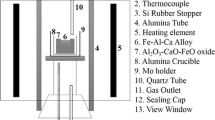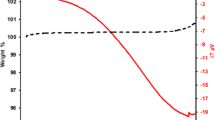Abstract
Effects of Cr, Al and Hf, varied from 0–32 wt.%, 1–7.5 wt.% and 0.3–1.5 wt.% respectively, on reactions between nickel base alloy melt and silicon oxide core were investigated in this paper. Role of temperature also was studied. Morphology and structures of reaction products were analyzed by scanning electron microscope (SEM) with the energy dispersive spectrometry (EDS) and the X-ray diffraction (XRD) technique. Amount of alumina in interface increased with Cr level, and formed a layer with thickness up to several microns in alloy of 32 wt.% Cr, and 1 wt.% Al. Reaction products in alloy without Hf were mainly alumina, while in alloy with Hf were mainly hafnium oxides and alumina. More hafnium oxides were formed in alloy with 1.5 wt.%Hf and 9 wt.% Cr, while more alumina formed in alloy with 0.3 wt.%Hf and 15 wt.%Cr, a double layer of reaction products formed at the temperature of 1540 °C, which were composed of a hafnium oxide layer near the metal and a alumina layer above it. The result shows that Cr, Hf levels in the alloy and reaction temperature have the effect of accelerating interface reaction.
Similar content being viewed by others
References
Li B.S., Zhang Z.Q., and Jiang H.Y., Study on metal/shell interaction in ZrO2 ceramic mould during titanium investment casting, Jounal of Aeronautical Materials, 1999, 19(2): 43.
Liu A.H., Li B.S., and Nan H., Interfacial reaction between TiAl base alloy melt and oxide mould, Rare Metal Materials and Engineering, 2007, 36(11): 1975.
Garfinkle M., and Daris H.M., Reaction of liquid titanium with refractory compounds, Trans. ASM, 1965, 158: 521.
Jiang H.Y., Li B.S., and Guo J.J., Study on interaction of Ti melt and ceramic interface, Foundry, 1998, 4: 22.
Peng D.L., and Wang W., Ceramic core of titanium alloy precision casting, Foundry, 2006, 55(10): 1082.
Xiao F., wettability of molten ni-5 wt.% alloy with solid polycrystalline alumina, Chinese Journal of Nonferrous Metals, 14(3): 454.
Zhu Y., and Yang Y.Q., Activity coefficients for components in Ti alloys and intermetallics, Rare Metal Materials and Engineering, 2003, 32(8): 600.
Chen Y.Y., Niu H.Z., and Tian J., Interfacial reaction between Ti-47Al-2Cr-2Nb-xTiB2 alloy and Al2O3 ceramic molds, Special Casting & Nonferrous Alloys, 2010, 30(3): 197.
Gao Y.S., Pang W., and Li Z.H., Preparation of calcium zirconate and interfacal reaction with molten titanium alloys, Journal of the Chinese Ceramic Society, 2009, 37(12): 2007.
Sheng W.B., Li D., and Yang R., Study of the reaction at TiAl based alloy/permanent mold interface, Journal of Materials Engineering, 2001, 8: 11.
Liu H.B., Shen S., and Mao X.M., Ti-6Al-4V alloys casting into BN composites investment, Materials Review, 2007, 21(z2): 419.
Xie W.S., Study on Interaction of Nickel Superalloy and Ceramic Shell and Mechanical Properties, Harbin Institute of Technology, Harbin, 2002.
Gong R.C., Li B. S., Yang Y.C., et al, Analysis of white matter in endosexine of ceramic mold for Ni-based high temperature alloy, Foundry Technology, 2003, 24(6): 517.
Thomas M, Materials development in aero gas turbines. proceedings, [in] The 5 th International Charles Parsons Turbine Conference, Cambridge, London, 2000: 710.
Dina R, Taarea A, William F, and Jeffrey W. Fergus, Reaction between constituents of two molten nickel-base superalloys and ceramic materials, [in] Proceedings from Joining of Advanced Specialty Materials, Pittsburgh, Pennsylvania, ASM International, 2003: 13.
Author information
Authors and Affiliations
Corresponding author
Rights and permissions
About this article
Cite this article
Li, Q., Song, J., Wang, D. et al. Effect of Cr, Hf and temperature on interface reaction between nickel melt and silicon oxide core. Rare Metals 30 (Suppl 1), 405–409 (2011). https://doi.org/10.1007/s12598-011-0313-6
Received:
Revised:
Accepted:
Published:
Issue Date:
DOI: https://doi.org/10.1007/s12598-011-0313-6




